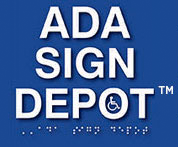My Life With Paralysis, It’s a Workout
ADA Sign Depot
January 11, 2017
 My Life With Paralysis
My Life With Paralysis
{ Shop all our Handicapped Parking ADA Signs }
ADA Sign Depot:
Imagine being a high school track athlete one day. And paralyzed the next. The one minority group every American can suddenly become a member of is the disabled. According to Social Security Administration disability facts: “The sobering fact for 20-year-olds, insured for disability benefits, is that more than 1-in-4 of them becomes disabled before reaching retirement age.”
Full Article | Source: NY Times
by Valerie Piro (Valerie Piro is a student at the Harvard Graduate School of Education.)
I believe strongly that everything should have been made accessible yesterday, but I also would choose an abled version of myself over my current self any day — it’s easier and more time-efficient to manage.
The alarm goes off at 4:30 a.m. Groggy, I turn on the lamp on my night stand and try to sit up. I put my right hand on the wall next to my bed to steady myself, and push my left into the bed. Right away, my abs and back seize up and my legs spasm and kick out straight, forcing me back down onto the bed. Clearly my body thinks it is too early to get up, but I don’t have time to argue with it. I have to get physical therapy out of the way so I can be on time for my medieval history class.
After I sit up, I place my hands under my right knee and clasp them together as I bring my knee up and closer to my chest. I reach out to my right foot and cross its heel over my left thigh so that I can plant my heel on the bed. I hug my right leg against my torso and chest and feel a stretch in my lower back and butt. I repeat this on my other side and then proceed to stretch each ankle.
Paralysis requires maintenance.
I then hop toward the foot of my bed, where my commode chair sits. I set both feet on the footrests as best I can, grab the armrest on the far side of the chair with my left hand, and, using my right hand to drive down into my bed, lift myself onto the commode wheelchair, and wheel to the bathroom.
I emerge at 5:35 a.m. I transfer now into a wheelchair whose dimensions are friendly toward my Functional Electrical Stimulation (F.E.S.) cycle — something like a gym exercise bike, without the seat. I pull some milk out of the mini-fridge and pour it over a bowl of cereal. I eat while checking and answering email. At 6:30 it’s time to start cycling. I put two small rectangular electrodes on my left shin muscles, and then two on my right, connect them to the cycle, then strap in my legs and feet. Then two more electrodes then two more, and so on, until most of my lower body is tapped and wired. After I turn on the tablet that’s attached to the cycle, I choose from one of several preset programs to start my workout. Within a couple of minutes, electrical shocks are pulsing into my legs, causing them to contract into pedaling. Imagine pedaling a bicycle uphill for an hour; this is my workout.
Still, I’m groggy. I spend the hour feeling various muscles contract, occasionally nodding off and jerking back awake, and thinking about paper topics for my three history classes, a Latin translation I need ready by the next day and an email I need to send an adviser, and wondering if I should keep my laptop next to my cycle for the next workout so I can pedal and binge watch “30 Rock.”
O.K., almost there.
At 8 I take my electrodes off, bag them and transfer back into my bathroom wheelchair and wheel to my shower. By 9, I am mostly dressed. I transfer to a third wheelchair, a power-assist whose batteries had been charging overnight. I have 30 minutes to blow-dry my hair, make sure my bag is packed, apply enough makeup to cover my acne, and put on my sneakers and jacket, before heading to the shuttle that will take me to my college’s main campus.
By 9:45, I’m outside my Making the Middle Ages class. I wave slowly at a classmate across the hall.
“Hey, how are you?” she asks, “You look tired.”
“No, that’s just my face,” I say, and laugh a little. If you’ve read this far, you’ll understand why I didn’t go into more detail just then. My mornings are complicated.
- Tags: ADA People Subscribe to this blog's RSS feed.


